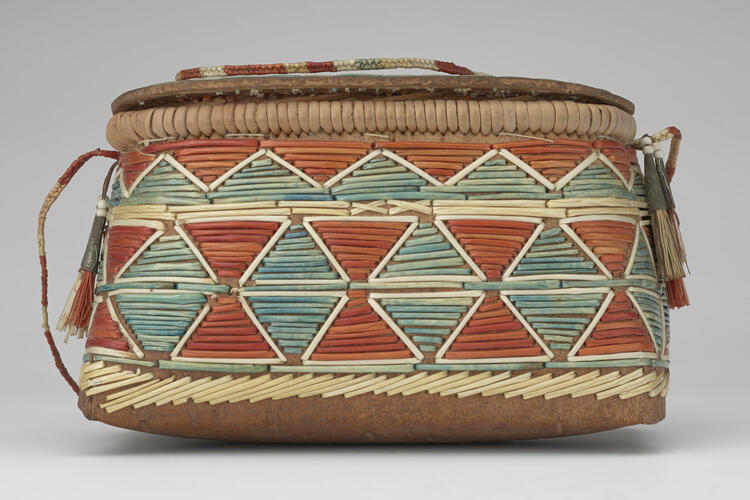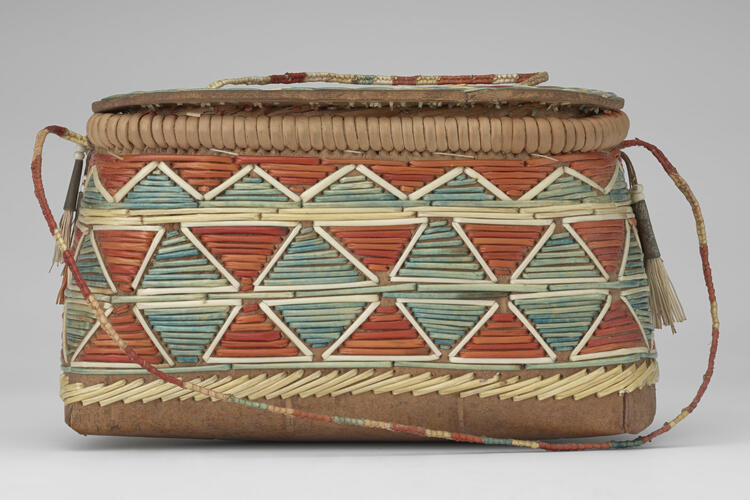-
1 of 253523 objects
Basket ( 1860
Birch bark, buck skin, porcupine quill, sweetgrass or wrapped root, metal, deer hair | 7.5 x 12.0 x 8.0 cm (whole object) | RCIN 84306

Polly Soper (c.1806-c.1891)
Basket (makak) 1860

Polly Soper (c.1806-c.1891)
Basket (makak) 1860

Polly Soper (c.1806-c.1891)
Basket (makak) 1860



-
Mississaugan birch-bark basket (makak) and lid, with the basket exterior decorated with quillwork triangles and the lid with quillwork leaves. The lid has a sweetgrass handle wrapped with quills, secured with cotton ties on the underside. Inside is a piece of braided sweetgrass with wrapped coloured quills at intervals. The wrapping on the box rim may be spruce root or split ash. On either of the short sides are metal tinkle cones with fine fringes, likely of deer hair, dyed to match the quillwork decoration.
The hourglass and zigzag motifs are somewhat archaic for the mid-nineteenth century, being more commonly found on eighteenth-century medicine bags and formal garments. By 1860, these designs had typically been replaced by floral motifs. Their use here is redolent of the symbols for the thunderbird and underwater panther - spirits of the upper and lower worlds respectively.
Sweetgrass is one of the four sacred medicines used by the Michi Saagiig alongside sage, tobacco and cedar. It grows naturally across traditional First Nations territories. When braided it may be used for decoration, as here. The quill ties securing these braids may be intended to evoke the four sacred colours – yellow, red, white and black – though the latter appears a pale blue. Sweetgrass is also burnt in sacred fires, sweat lodges and smudging ceremonies, where it acts as a spiritual purifier.
Polly Soper, aged 55, was married to Robert Soper (aged 45) and was listed as unable to read or write on the 1861 census; Margaret Taunche, 80, widow, family member lived with them. In 1848, Polly had won Best Hand Basket and Cradle at the Cobourg Fair. Biographical information provided by Dr Laura Peers, Dr Lori Beavis and community members.
This basket is one of more than a dozen birchbark containers presented as gifts to Albert Edward, Prince of Wales (later King Edward VII) in September 1860 by Michi Saagiig women. The prince visited the community at Rice Lake Village (now Hiawatha First Nation), Ontario, during a landmark two-month tour of Canada – the first royal tour of these territories.The baskets are known as ‘makaks’ in Anishnaabemowin, an Indigenous language spoken by the Michi Saagiig (Mississauga First Nation) community. Most are decorated with porcupine quillwork using a combination of Indigenous geometric and European-inspired floral designs. Unusually, the names of the women who made the makaks are preserved, on handwritten paper labels or quilled birchbark tags.
The meeting at Rice Lake was an important opportunity for community members to acknowledge and renew their special relationship with the Crown. Gimaa (Chief) Paudash made a speech expressing their identity as sovereign nations allied to the Crown – a bond which stretched back hundreds of years. The presentation of the makaks and other gifts signified the renewal of these allegiances and obligations.
After the prince’s return to Britain, the makaks were displayed in the Swiss Cottage Museum at Osborne House, Isle of Wight.
Provenance
Presented to Prince Albert Edward (future King Edward VII) by Betty Soper of Rice Lake, Canada, in 1860
-
Creator(s)
(nationality)Acquirer(s)
-
Medium and techniques
Birch bark, buck skin, porcupine quill, sweetgrass or wrapped root, metal, deer hair
Measurements
7.5 x 12.0 x 8.0 cm (whole object)
Category
Place of Production
Ontario [Canada]